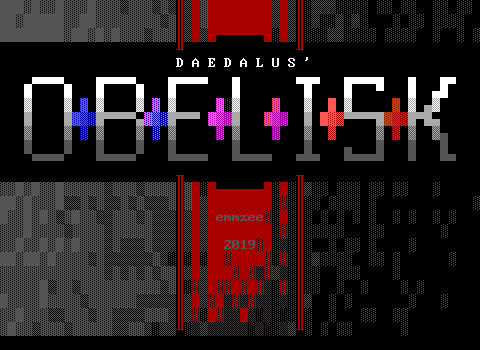The poll winner for this month's Closer Look is an Interactive Fantasies title that for once isn't of my own choosing. Instead, it's a game I hadn't played before, or honestly really heard of: Interstellar Police: Escape Stal' Prison. Sorry in advance to author Bob Pragt who has recently rejoined the ZZT community and become a regular in streams and on the Discord server. Of course, what's more likely is he's seeing this article going up and getting that sinking feeling in his stomach one often gets when you realize somebody is diving into something you made at the tender age of fifteen.
Since this was a poll game that I was unfamiliar with, when it was time to write a short description, I winged it based off the game's opening text. You are Matt Sullo. You have been captured by aliens, and now must escape their prison ship and find a way back home. The vagueness of my description wasn't wrong, but Bob wasted no time in proving that his game was not what I went in expecting. Sci-fi settings have long been popular ones for ZZT worlds, easily going back to the early 1990s with titles like 1992's Starbase ZZT by prominent early ZZTers Jerry Hsu and Jesse Chang, as well as Space Station ZZT from roughly the same era by the same duo. ASCII characters lend themselves well to strange technology, whether it be alien or human. Drawing a star-laden backdrop in ZZT is one of the quickest scenes to design, with half the work already done thanks to the solid black backgrounds of an empty ZZT board.
There's never really been a time when you couldn't find a then contemporary sci-fi game, even ignoring the numerous ones based on existing properties including Star Wars, Star Trek, or Alien. 1993 has Alexis Janson's The Robots of Gemrule. In 1994 myth gave ZZTers the iconic first entry in the Fred! series with Space Fred! and a re-release the next year. Tseng's "Da Hood" universe encapsulates nearly all of his work from the 90s, with interplanetary travel being used to whisk players away to whatever actual setting was needed. Modern titles like Zephyr's 2020 masterpiece On A Distant Moon and the retro-styled The Mars Rover (by yours truly) keep the genre alive today.
All of these titles play in a similar manner, despite wildly different presentation. You are in an alien environment, and whatever needs to be done to reach the end is going to involve a healthy amount of shooting, whether it be bullets or lasers. It's a tried and tested style.
Similarly, the back half of the title Escape Stal' Prison also evokes the cliché of the ZZT prison escape, a long running tradition across games of all genres and themes. Players frequently find themselves in cells and have to find their way out, with the initial escape usually being just one small part of a grander adventure.
So it's easy to look at Interstellar Police's title and background story and have some pretty strong preconceptions of what to expect. Depending on tone, Mr. Sullo will no doubt improvise a crude explosive to blast down his cell door, or perhaps dig your way out with a spoon, or maybe he'll stab a guard with a sharp rock. The options are limitless, but the odds are good that this will be a game that sticks to the established formula.
Therefore, I was rather surprised at the way Bob really bucked tradition here! Interstellar Police sounds generic and formulaic, but it wound up starting out quite strong, taking the game in a direction that I was really not expecting it to go. Its fresh take on both ZZT sci-fi and the ZZT prison escape game wound up making the game add up to something much more modern feeling in design than its core components would lead players to expect. Could Interstellar Police be another instance of a Closer Look leading me to an overlooked gem as with Invasion ZZT Revision and The Lost Pyramid before it?
Almost.
Take note that I described the game as starting out quite strong. The aspects of Interstellar Police that make it a well above average ZZT world from the turn of the century don't stick around for the entire show. I've been burned by games that seem impressive in the beginning before. The real question is just how low we're going to go here. Does the game fall apart completely, or does it simply lose its initial inertia and turn into a resounding "meh"? There's only one way to find out.

Background Story. Like, Really Background.
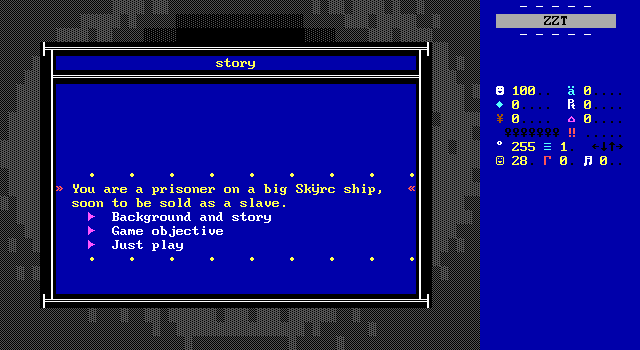
The moment the player chooses to play from the main menu they're taken the first gameplay board and given this tl;dr of the story. You're a prisoner of some aliens known as the Skÿrc, and going to be sold into slavery. That's the story. It's a simple premise, easy to understand, and being an easy motivator to take drastic actions to escape. But there's the option to get a little more information which quickly and wildly changes the scale of the events of the game, and of course I had to take a look.
The background information reveals a lot about the universe the game is set in. Players take on the role of "Matt Sullo", a member of the I.P.R.T. which is then explained to be short for the "Interstellar Police Research Team", a division of the I.F.M.I. which is then in turn explained to be short for the "Interstellar Federation of Military Intelligence". The player is then presented with another choice to learn about the I.F.M.I. and that's where things really veer off course.
The I.F.M.I is an alliance of four sentient races: humans, Ditoans, Intels, and the Martians. It was formed after the first "space war" fought between the Intels and AMDs Ditoans. This war is irrelevant to anything in Interstellar Police. These alien races are irrelevant to anything in Interstellar Police. No mention will be made of any races in this game that aren't human nor Skÿrc.
What's at least somewhat relevant to how poor Sullo got put on a prison ship is a rumor going around that the Skÿrc are planning to go to war against the federation. The Skÿrc get a lot of backstory as well. Their whole deal boils down to a simple evil alien society. They're warmongers and might-makes-right throughout their entire civilization. It's the sort of thing to quickly set up your basic good versus evil. That should really be the end of it, as it's enough to say "hey these guys want to sell you into slavery" to make it clear that they are in the wrong here morally. Instead, Bob goes a bit deeper into their society, perhaps to set up a bigger universe ripe for other ZZT games to be set in, be they sequels or spin-offs of this one.
The Skÿrc live on... Skÿriac! They have five leaders, and when one dies there's a big fight to the death among those that intend to take their position for themselves. Skÿrc society is one where the strong rule, with leaders frequently dying and these power vacuums occurring simply because of how often the leaders go to war with one another. Those that are weak are forced into slavery, including forced military service used for these civil wars. Those that are strong train their whole lives to potentially become one of the leaders of Skÿrc society. Strong or weak, it sucks to be a Skÿrc regardless.
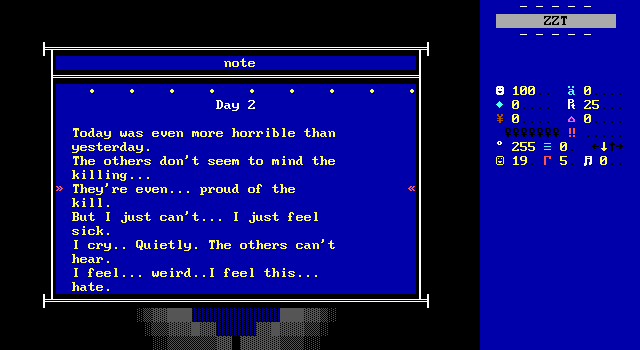
This busted system could use a retooling, but there's no real way to do so. Unfortunately for them, the Skÿrc have recently become aware of the federation and word is slowly spreading about what kind of lives those in the federation have. Lives free of slavery and without the unending bloodshed. Some Skÿrc, having learned about this are beginning to demand change. The movement isn't doing so well for them though, as the establishment has no qualms with simply killing anybody that speaks such things. Interstellar Police however, is not the story of Skÿrc revolutionaries, so don't get too attached. It will not come up. It does not matter for this game. While the possibility of a game based around starting a revolution within an alien society could be an interesting one, it will not be happening today.
What it all boils down to is that because of the threat to the status quo, the Skÿrc want to take out the federation lest their way of life becomes forced to change. Matt Sullo was sent to Skÿriac to confirm the rumors that they're building up for war (with the federation, they're surely building up for war with each other). As well as doing some intel gathering on this species that isn't particularly well known to the federation. The opening scroll describes this in a clumsy way, suggesting Sullo's mission is to learn about their "language and anatomy". In particular, to learn their weak points, and perhaps on the side, to rescue some political prisoners that were made into slaves rather than just killed outright.
Wouldn't you know it though, the mission was a failure and Sullo was quickly caught. Probably due to the anatomical differences. They didn't Avatar him or anything. The original plan was of course to kill him, but due to his unique role within the I.P.R.T. he's more valuable alive as a prisoner, and as long as they've got him, why not do a little slave labor with him on the side?
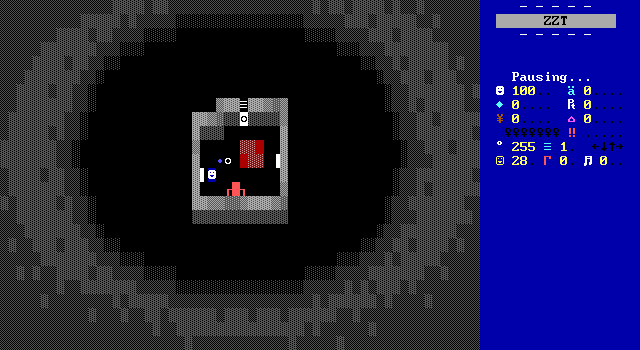
Basically nothing above matters though. Skÿriac, their society, the Interstellar Police, pretty much all of it can be forgotten about immediately. In fact, readers will be surprised to learn that despite the game taking place on a Skÿrc prison ship, Sullo's escape will not once bring him into a struggle with a Skÿrc. What Bob suggests in his introduction (and what I assumed when I put this game onto the polls) is that this will surely be an action title. A ZZT prison escape sequence is cliché, but so long as players are having fun, that hardly matters. I expected something along the lines of Lebensraum or Infestation if it was solidly made. And if it wasn't, then maybe Escape From Zyla Island at least.
Effortless Escape
Where Interstellar Police quickly sets itself apart from other ZZT prison escape sequences, both as events in larger games as well as those where escape is the entire premise, is that Sullo actually does very little to make his escape. Instead he's taking advantage of an emergency on the ship, finding a way past the doubly-locked cell door that keeps him prisoner, and afterwards focusing on what happened rather than getting into shootouts with Skÿrc guards or sneaking around to avoid fighting entirely.
Interstellar Police is unexpectedly much more of a horror game than an action one. The only genre tag as of writing is "Adventure", the catch-all genre that often says very little about a game with the label, especially with no other genres to provide context. Once Sullo is out of his cell, the game revolves around investigation and exploration to figure out what's happened. Even with the survival horror vibes, it doesn't feel like that's the intent either. The game is more like exploring an abandoned building than one filled with monsters. It's more suspense than survival. The later portions of the game, once Sullo realizes what he's really dealing with, bring the tension down considerably. Everything's scarier when it's all in your head after all.
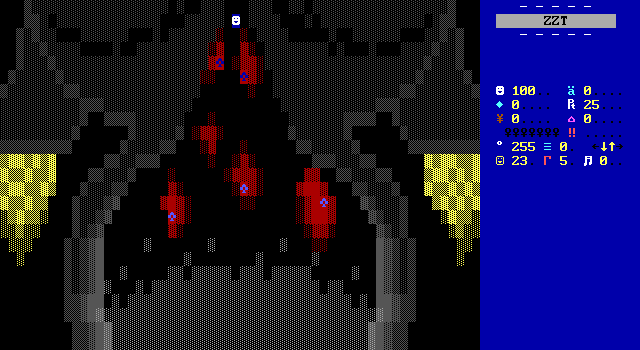
Guards stationed on Stal' prison are found already dead, often in rather violent ways. For another surprise, despite this game being vintage 2000, the gore isn't meant to be part of the game's appeal. Sullo has to take an analytical approach to figuring out what's happening here, investigating which parts of the ship's rooms are damaged and which remain unscathed. A lot of the narration early on is Sullo contemplating whether the ship was attack by an outside force or if this was the result of an inside job. Sullo regularly notices details to piece together the events that unfolded before he left his cell. For example, Sullo may take notice that a dead Skÿrc's appears to be clutching a gun that's no longer there, or will determine that a Skÿrc was ambushed from behind as all of their injuries are located in their backs. Some of the more unlucky Skÿrc can be found in pieces with crumbling walls from explosive devices, with Sullo interpreting the damage to determine how skilled the perpetrator was with their toys. Whoever is responsible for all this has shown the Skÿrc no mercy.
One early theory is that another ship launched a surprise attack, likely to board the prison ship to and rescue a prisoner or prisoners. But it can't be so simple. A few other prison cells are open as well with prisoners just as likely to be missing or lying dead from injuries similar to the ones suffered by the Skÿrc guards. The prisoners, including the dead ones, include fellow humans as well. Why were they killed, and why was Sullo allowed to live?
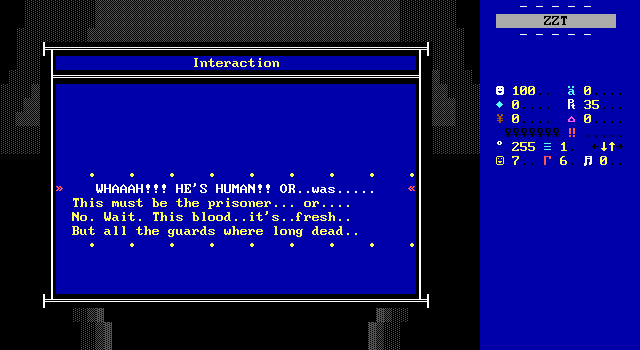
Disturbingly, while the guards have been long dead before Sullo even makes it out of his cell, the human kills are considerably more recent. Bob does a remarkable job creating a tense atmosphere in ZZT, always a challenge, and even more so when you recall the game's info screen stating that Bob was only fifteen at the time. Horror has a bit of a resurgence in the ZZT community, and is generally a genre that older titles really struggle with as adolescents try to accurately portray their ideas in ZZT format. It's commendable that Bob is able to instill such a feeling of unease even today with this game that's now more than twenty years old.
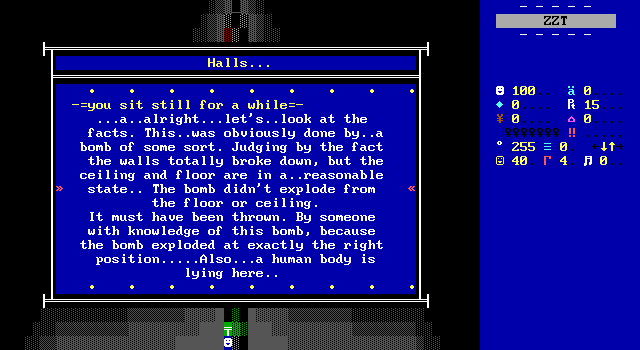
The commitment to investigation is what makes it all possible, with some extra help in Sullo's distinctively non-macho response to violence. Most rooms activate a description of the scene the first time players enter, and the gorier the killings, the more Sullo struggles to look. Sullo often throws open a door, steps inside a room, and freezes in place, looking away from the sight that lays before him. In one case Bob sees fit to have Sullo vomit at the sight of Skÿrc giblets strewn across a board thanks to a massive explosion. As a trained professional, Sullo is able to collect himself and shift into an analytic mode, knowing that understanding what happened here, and what may soon happen to him, are critical if he's going to make it off the ship alive. No matter how much training he may have had though, there are some things one can't un-see.
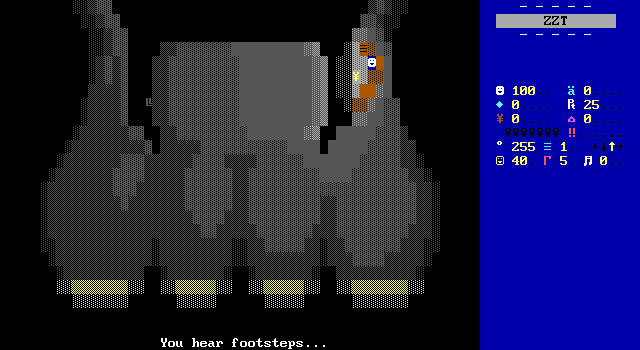
As if this wasn't enough to get the mind racing, for as much time as Sullo spends asking the obvious question of "what happened here?", he also spends significant time on the more pressing issue of "is the party responsible for this still on board?". For Bob, this is played up with investigation sequences frequently having moments where ZZT's sound is employed to create noises of somebody moving around the ship, with Sullo unsure if he's just imagining things in his panicked state or if those really were footsteps around the corner.
It all combines to form a tense atmosphere that I didn't think few, if any ZZT worlds, really managed to pull off for me prior to later Interactive Fantasies release, Deceiving Guidance the following year. A game whose themes of being trapped and only being able to go deeper into the lair of the dark elves makes it one of only a handful of ZZT worlds best played with the lights off. Bob is absolutely onto something here that's a stark reversal of expectations from the lengthy background story. The potential war between the Skÿrc and federation can take a backseat to getting off this ship alive.
Or at least, that's how it begins.
Eventually Bob makes the critical mistake of explaining things. There's still plenty of mystery, but when the person responsible for all the explosions, gun shots, and suffocations starts speaking of the ship's communications systems the atmosphere vanishes, leaving players gasping for air as the game pivots to a more traditional ZZT world. By the end of it, Sullo will be blocking blink walls with sliders and boulders and dodging Mission: Enigma knives. You hate to see it.
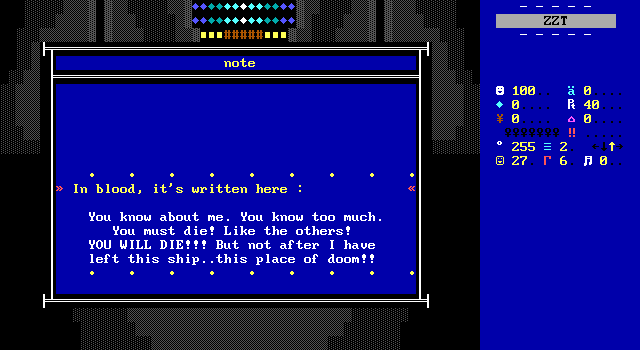
The latter half of the game is much more what you'd expect out of a twenty year old ZZT world designed by a fifteen year old. The game becomes far more baseline space adventure, with its more unique attributes being discarded. That being said, even if the middle of the game isn't nearly as attention-grabbing, had the entirety of Interstellar Police played like it does at its weakest, I'd have still had an enjoyable experience and overall considered the game to be a fun little sci-fi game of cat and mouse. With the strong beginning, the dip in quality brings things from impressive to adequate, which can't help but sting a little, but let it be said this this is not a game whose appeal is eventually lost altogether.
Interstellar Police is also not without its missteps in terms of maintaining the creepy atmosphere when it's still actively trying to be creepy. On one board, investigating a closet reveals a dead human inside, one of the other prisoners on the ship. Sullo makes note that the blood is still fresh compared to that of the Skÿrc guards on the ship seen earlier. Despite everything that he's seen up to this point, his mind immediately rushes to the possibility that it was a suicide of all things. The theory is good for a laugh at least. I can perhaps see it as a moment of wishful thinking that the person responsible for this went and took their own life as well, and having Sullo go into denial could be a way to actually make the game more suspenseful with players now trying to guide a character that is beginning to draw some very poor conclusions about his surroundings. The potential to get even more psychological doesn't come to pass as Sullo realizes there's no chance for his pet theory once he determines the cause of death to be multiple stabs in the back. Not exactly a popular method for suicide to be sure. No note is made of the fact that the body was found shoved in a closet which would have been enough for me to believe murder over suicide even if it had been the first thing amiss on the ship. By this point Sullo has been demonstrably pretty good with his investigations, making his jumping to conclusions and missing of an obvious flaw in his theory seem rather out of place for the character even if his mistake is caught soon enough.
Puzzle Pieces
Without any of the direct action you would expect to see from ZZT worlds of this era and setting, the question remains of what it is you actually do to help Sullo get off the ship. It's some very light puzzle elements that mostly boil down to key and door gameplay, without actually using literal keys and doors. Sullo will have to track down specific items required to be access or survive elsewhere on the ship. While the setting of prison ship which Sullo has never had the luxury of exploring before would lend itself well to something more open ended, the game is almost completely linear.
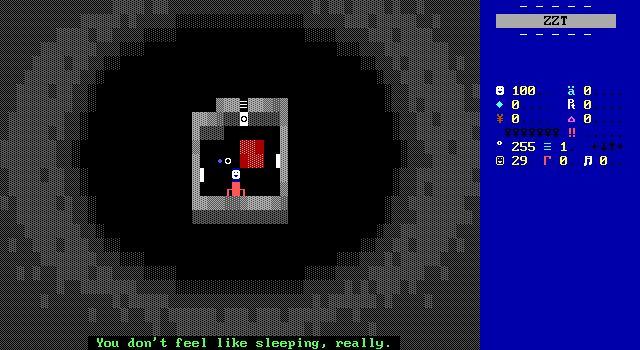
The first puzzle is, of course, to find a way to escape your cell and start exploring the ship. The cell door is noted as having two locks, one electronic and one mechanical in case of an electrical failure. For players this means the usual ZZT prison escape of repeatedly touching the limited number of objects in your cell until prompts to do things show up. Sullo's arsenal to MacGyver his escape with includes a plate of food, a mattress spring, and a glass of water. Many of which are accompanied by some silly animations that play out in the flashing messages displayed on the bottom of the screen. Some red herrings exist as well, with the rather peculiar decision made to include paintings hanging on the cell walls. Given how the Skÿrc are depicted, I'm quite amazed that the cells are as nice as they are.
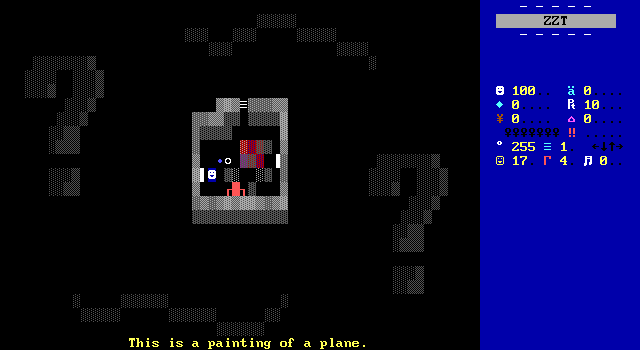
Sullo himself isn't much of an aficionado for the arts though. Touching any painting once will only describe its subject in plain terms and any subsequent touch commands return a generic message about not wanting anything to do with it. Sullo is quite the critic apparently. I was expecting the solution here to involve a hidden passage or item behind the paintings, but they really are only decorative. The other cells include them as well and really give some strange insights into what Skÿrc art is like as each of the cells are almost themed. Sullo's contains a painting of a tree and a painting of a castle. Another cell focuses on vehicles with paintings of a plane and a car. Another goes for more tranquil scenery with a sunset and a boat on a lake on display. It's a detail too weird to not focus on honestly. The moment I realized the paintings were going to be unique on each board, I rushed to see what would be on display in each room, forgetting momentarily that there was a good chance that whoever killed everyone else on board was still hanging around somewhere.
In terms of the game's puzzles, the opening again starts off on a better track that it finishes on. Once out of his cell Sullo can examine multiple other prison cells and is offered a split path with no real guidance. The exploration and investigation starts off nicely, but players are quickly locked into doing things in a very specific order which makes the softball puzzle design even weaker. The game often provides players with the tools they need to get past an obstacle before they realize that obstacle exists, making it easy to approach a new board and have whatever obstacle was supposed to be there already be handled. Similarly, it means the only real way to fail at most of the game's puzzles is to just ignore items lying on the ground.
The one counterexample I can offer is another source of frustration: A split path with two doors, where picking the "easy" door results in an explosive being set off and ending the game instantly. I tend to not consider instant game-overs to be as severe as others have in the past with ZZT as it's so quick to save and load that progress is rarely really lost. That's all well and good when the player is satiating their curiosity with absurdities like eating living bats in The Thief or pressing buttons that read "DON'T TOUCH" such as the infamous alpha in Dungeons of ZZT. Here the deaths tend to be fairly abrupt and provide little amusement in their descriptions which tend to be the real appeal of purposely making stupid choices in games. Sullo is killed with little fanfare.
Another puzzle requires providing a password to disable invisible lasers on another board that the player hasn't seen yet. (Oh, you know what I mean!) This amounts to writing down some symbols seen earlier and repeating them to little satisfaction. Wrong entries on the password prompt cause an instant death as well so be sure to write down any Skÿrc language when you see it.
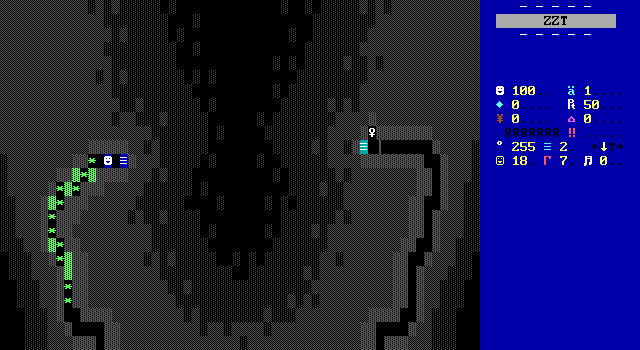
Some of the puzzles also just get a little silly, which normally wouldn't be a thing, but here manages to dump some ice cubes onto the already rapidly cooling tension of the game. Sullo can find a gas mask, but it's designed for Skÿrc rather than humans and the anatomical differences mean it's not a good fit. This is solved by finding some glasses elsewhere jury-rigging it together in a way that I won't begin to try and comprehend.
Not only is is a bland puzzle, but it also raises a lot of questions about Sullo's mission. Skÿrc anatomy is different enough that their equipment requires modification for human use, yet apparently Sullo was just supposed to show up and do some spying without sticking out immediately?
At one point Bob turns to ZZT puzzles in the traditional sense. One room has security lasers which are nothing more than blink walls. A pile of boulders and sliders needs to be shoved around to be able to reach them, and care has to be taken to not only clear the path, but to be able to use some of those puzzle pieces to block the blink walls. While this is again not what I would have expected from the start of the game, or even as the tone shifts upon reaching the lower deck, it the clear winner of all the puzzles within Interstellar Police. the screen is densely packed and it took quite a number of attempts before I was finally able to block the lasers and make it to the rooms' exits.
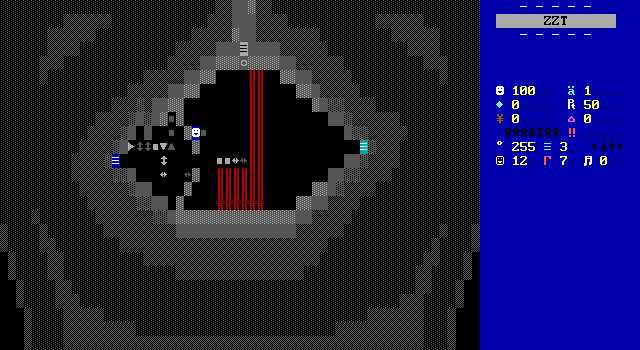
Nothing but respect for slider puzzles that are more fun than frustrating. The small scale of the components means that even with a lot of restarts from scratch there wasn't any misery to be had. It was short enough that I didn't want to bother with extra saves halfway through, making this bite-sized puzzle perfectly fulfill its role of impeding players without bringing the game to a halt.
In a supply closet packed with wood, gems, and boxes, Sullo finds an opened package that contains precisely one stone. It's another instance of a solution being delivered before a puzzle, intended to be used later on to block a door that shuts in front of Sullo after he's forced into activating a trap. The rock is actually represented as ammo meaning that the player has one shot available to them and needs to make it count. It's pretty obvious when it needs to actually be used, though the ability to use it at any time at least offers up an opportunity for players to experiment. Any such experiments will fail in the most mundane manner possible, as there's nothing in the game that reacts to being shot except the door it's intended for. The one and done nature means that even if devices were designed to react to the rock, it would still just amount to reloading immediately afterwards.
...Which is actually kind of silly since it's just an ordinary rock. If you throw a rock at a computer, you can pick up the rock. That's less of a point against Interstellar Police and more a genre problem with ZZT worlds that have a habit of making a gameplay mechanic out of the single shot mechanic (see Pop).
- [1] Actually, it turns out turning around isn't an option. As soon as the player steps foot on the lower decks, the passage back up will take them to an alternate board where the villain, acting particularly out-of character, confronts Sullo in plain sight and simply shoots him to death. This also prevents players from returning to check the password written in Skÿrc used to disable the invisible lasers as well.

